Powerful Owl
Powerful OwlNinox strenua | |
|---|---|
| Kingdom: | Animalia |
| Phylum: | Chordata |
| Class: | Aves |
| Order: | Strigformes |
| Family: | Strigdae |
| Status | |
| World: | Least Concern (ICUN Red List 2025) |
| Australia: | Not Listed (EPBC Act) |
| Victoria: | Vulnerable (FFG Threatened List 2025) |
| South Australia | Endangered |
| Queensland | Vulnerable |
| New South Wales | Vulnerable |
| FFG: | Action statement No. 92 |
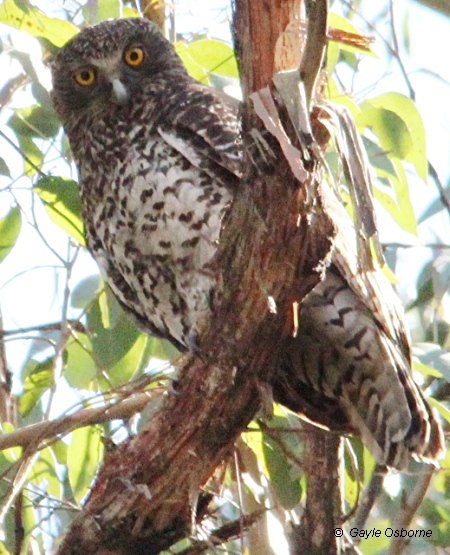
The Powerful Owl is symbolic as being one of the supreme nocturnal predators in the forests of south-eastern Australia, it is the largest species of owl in Australia and its presence as a high level predator may serve as an indicator of forest health because it is reliant on forest ecosystems that support abundant wildlife.
The Powerful Owl is closely related to the lesser known Barking Owl Ninox connivens and the Southern Boobook Ninox novaeseelandiae, all three being categorised as ‘hawk owls’, owls that do not have the typical facial disk of ‘barn owls’.
The Powerful Owl reaches a size of 67 cm for males and 58 cm for females which is substantially larger than the Southern Boobook Owl (30 cm) and larger than the Barking owl (40cm). Adult plumage is mostly brown on the head, back and upper wings with light coloured barring when viewed from the back, underparts are mostly white with horizontal brownish vee shaped barring (chevrons). Juveniles have more white plumage in front and on the head with obvious darker brown areas surrounding the eyes. The adult face is dark brown around the eyes with a lighter coloured forehead, the eyes are orange/yellow and the bill is black. The feet are yellow with black talons, the feet have a very strong grip for holding prey.
The Powerful Owl can be distinguished from the smaller Barking Owl which has vertical streaks rather than barring across its front (Juvenile Powerful Owls have some sparse vertical streaks but not as obvious as the Barking Owl). The Powerful Owl also has more barring across its back rather than the white spots of the Barking Owl.
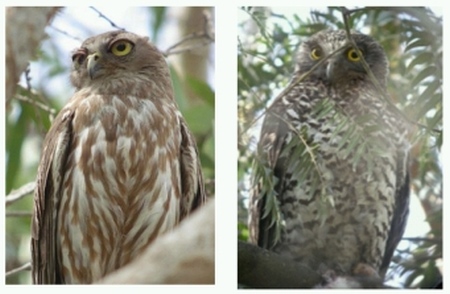
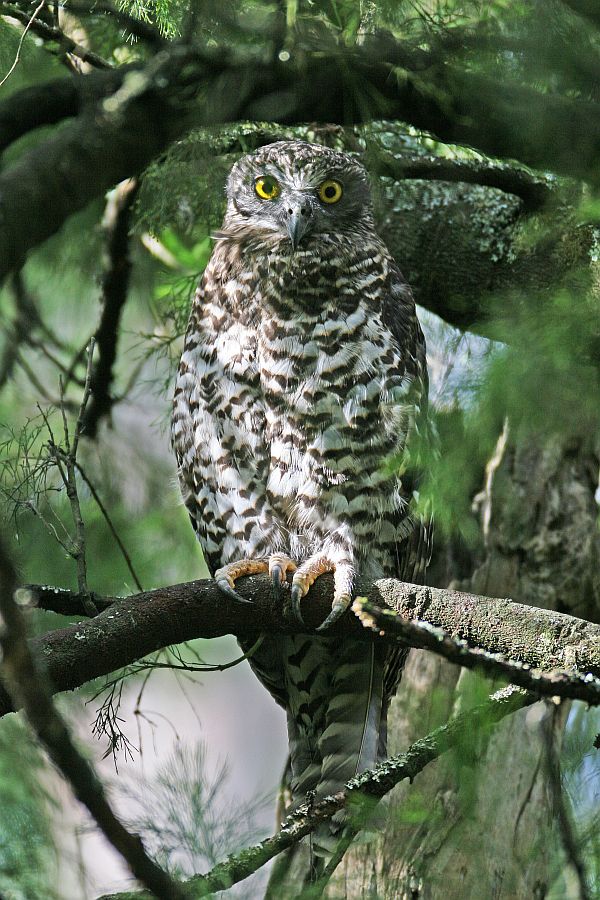
Distribution
The Powerful Owl occurs along the south-eastern fringe of mainland Australia from southern Queensland into New South Wales and Victoria. In Victoria it occurs across the eastern highlands extending into south-west Victoria. Most records occur in forested areas, in the south-west records exist in the following biorgeions; Central Victorian Uplands, Goldfields, Greater Grampians, Glenelg Plain, Otway Ranges, Otway Plain and Warrnambool Plain.
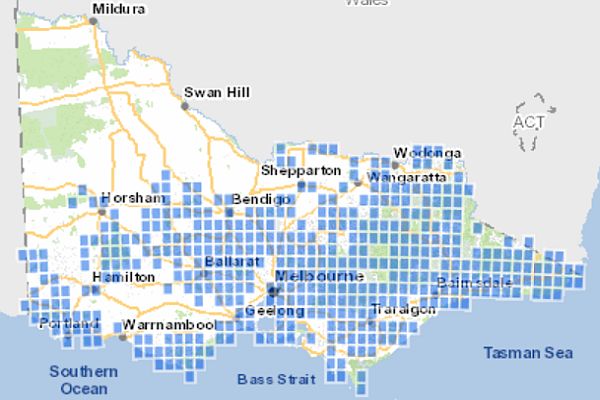
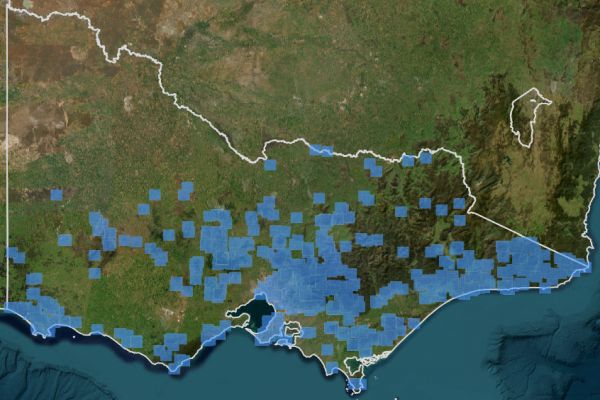
Records of Powerful Owl in Victoria from 2000 to 2024. Source:VVB 2024.
Visualising Victoria's Biodiversity - Interactive map link
Ecology & Habitat
There is a strong relationship between the occurrence of Powerful Owls and their habitat. They are forest dwellers which rely on areas of old growth forests that contain mature, live hollow bearing eucalypt trees that can be hundreds of years old. In a study of Powerful Owls near Melbourne, McNabb (1996) found a connection between habitat quality, home range size, diet and breeding success with owls in less productive habitat occurring more sparsely and breeding less successfully on a more generalised diet. Optimum habitat elements for fostering high breeding productivity, include high densities of large, live (old growth 150+ years) hollow bearing trees in sheltered positions and orientations.
Modelling the distribution of Powerful Owls in Victorian forests by Loyn et al. (2002) found that Powerful Owls favour the drier forest types which have many live hollow bearing eucalypt trees in association with Blackwood Wattles, diverse habitats and extensive mature forest within 2 to 5 km.
Powerful Owls may share tracts of forest with Sooty Owls and Masked Owls, but habitat modelling data suggest that Powerful and Sooty Owls have different requirements despite a broad overlap in distribution. Powerful Owls favour the more open forest and broad gullies, with plants such as Blackwood Wattle whilst Sooty Owls favour the wetter sites and rainforest with plants such as Silver Wattle, Blanket-leaf and Tree-ferns (Loyn et al. 2002). There is virtually no overlap between diets of Powerful Owl and Masked Owl, as they tend to forage in different places and take different prey. The Powerful Owl hunts for prey that almost exclusively lives in trees and mostly takes prey which is 50-100% of its own body weight whereas the Masked Owl takes smaller prey which is 3-20% of its body weight (Kavanagh 2002).
Feeding
The powerful owl is a generalist hunter, preying on the most available prey at a given site and in a given season (Cooke et al. 2006). The main component of the Powerful Owl diet across its range is Ringtail Possum, this may be supplemented by other arboreal possums and gliders depending on the geographic location and prey present, eg Greater Glider, Brushtail Possum, Sugar Glider, Yellow-bellied Glider (Cookeet et al. 2002). Birds, insects and vegetation comprise only a small part of the diet and ground dwelling mammals are rarely taken (Tilly 1982, Lavazanian 1994 , Kavanagh 2002, Cooke 2006). The rate of feeding probably depends upon the size of prey taken, McNabb (1996) estimated a pair would take a major prey item eg. possum every 3-4 days. Seebeck (1976) estimated a breeding pair might take as many as 250 possums per year.
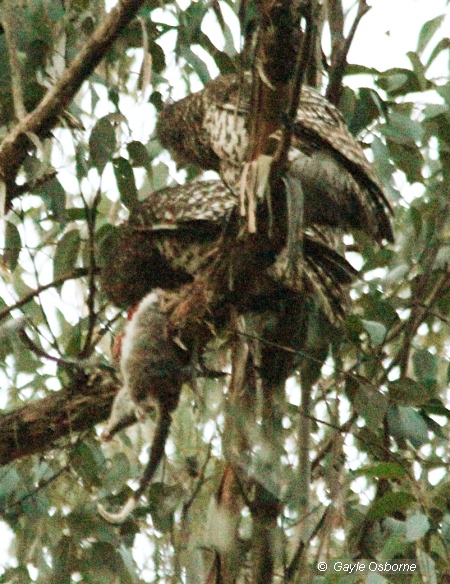
Summary of diet from sites in south-west Victoria
(from Seebeck 1976, Tilly 1982)
| Location | Main prey | Secondary prey |
|---|---|---|
| Point Addis | Rigtail Possum | Australian Magpie, Pied Currawong |
| Beaufort | Ringtial Possum & Australian Magpie | Pied Currawong, Sugar Glider, Brush-tailed Phascogale |
| Naringal East | Ringtail Possum | Sugar Glider |
| Linton | Ringtail Possum & Sugar Glider | |
| Aireys Inlet | Ringtail Possum |
Home range
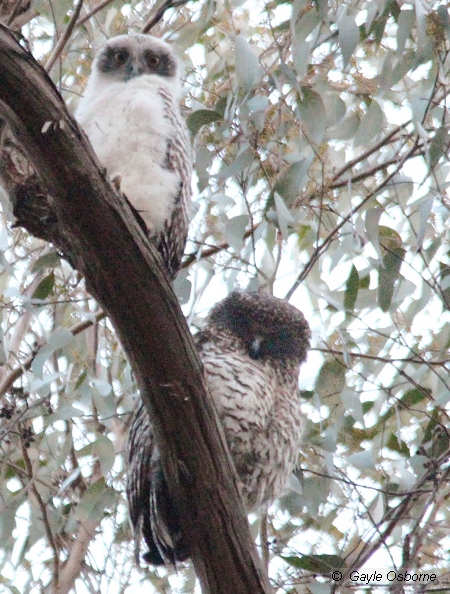
The extent of home range is influenced by habitat quality and subsequently the abundance of prey. In areas near Ferntree Gully, east of Melbourne where there was good habitat and an abundance of Ringtail Possum prey the home range was estimated to be 300ha (McNabb 1996), for areas in the Box-Ironbark forests of Victoria the home range could be from 1380 to 4770ha (Soderquist et al. 2002), but it is generally accepted to be about 1,250 ha or within a 2 kilometres radii (Loyne et al. 2002).
A pair of owls in urban environments on average need 638 ha /6.38km2 of space or 360 MCGs; this is much smaller home ranges compared to the estimates from owls in forested environments which are upwards of 2-3000 ha per owl. In the urban environment owls on average travel 4.6km per night or 10 MCG laps. See SWIFFT seminar notes 23 July 2020.
Breeding
Nest sites are selected high up in old, large living eucalypts (150 + years old). Nest hollows are large and can be about 1metre deep with an entrance nearly .5 m wide (Cooke et al. 2002). Owls may sometimes re-use nest sites or select a different hollow every 2-4 years. In Victoria it has been observed that laying takes place late May to a peak mid June with a nestling period 8-9 weeks during which one or two chicks are reared, post fledgling dependence lasts for 6-7 months (McNabb 1996).
Threats
A major threat to the Powerful Owl is a loss of suitable large hollow bearing trees which has a direct impact on the availability of nest sites and also reduces habitat that supports arboreal marsupials which comprise the majority of the owl’s diet.
Processes such as fire, clearing and thinning may lead to the direct loss of habitat trees or changes to the surrounding forest structure which may compromise the value of nest sites. Continual changes to forest structure may also reduce the availability of habitat for prey species such as Possums. Continual forest disturbance may also compromise the growth of replacement old growth (150+ years) trees which may never reach full maturity.
Loss of canopy vegetation may exposes mature eucalypts and render nesting sites unsuitable. Wide spread and frequent fuel reduction burning may thin out thickets of vegetation that support Ringtail Possums and other prey.
Land use changes from residential or industrial development around the eastern fringe of Melbourne needs to protect Powerful Owl habitat.
Intensification of agricultural activities resulting in the clearance of suitable habitat can be detrimental to Powerful Owls.

The above map demonstrates the impact of the 2019/20 bushfires in East Gippsland (grey shading), Powerful Owl survey sites with nil results (black dots) and positive results (red dots). Surveys were undertaken in 2020 post fire and 2021 with a total of 60 sites surveyed. (Source: Cripps et al. 2022).
Threat abatement measures across Victoria
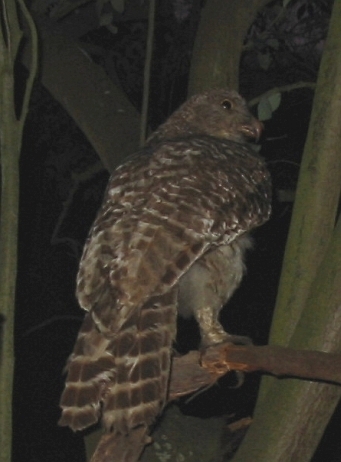
Creation of new reserves in Victoria, e.g. Great Otway National Park and Otway Forest Park combined with the cessation of commercial logging many areas of State Forest, e.g. Wombat State Forest has increased security to Powerful Owl habitat.
Powerful Owl Management areas (POMAs) have been identified across a variety of Crown land tenure to protect Powerful Owl habitat. For State Forests where clear-fell harvesting is used, areas of suitable habitat of at least 500ha (dependent on habitat type) are protected as SPZ within a 3.5km radius. Where selective harvesting is used, POMAs comprise Special Management Zones of about 1 000 Ha. In existing conservation reserves POMAs contain at least 500ha of continuous suitable habitat.
Conservation of the Powerful Owl will involve identifying at least 500 Powerful Owl Management Areas (POMA's) on public land across the known Victorian range.
Areas of private land that support Powerful Owls require protection with landholder support and through identification in municipal planning schemes.
Important Local Government Areas in Victoria for Powerful Owl
- Ararat Rural City
- Baw Baw Shire
- Benalla Rural City
- Cardinia Shire
- Central Goldfields Shire
- Colac Otway Shire
- East Gippsland Shire
- Glenelg Shire
- Knox City
- Latrobe City
- Mansfield Shire
- Maroondah City
- Mitchell Shire
- Moira Shire
- Moorabool Shire
- Mornington Peninsula Shire
- Mount Alexander Shire
- Mt Buller Alpine Resort
- Mt Stirling Alpine Resort
- Murrindindi Shire
- Nillumbik Shire
- Northern Grampians Shire
- Pyrenees Shire
- South Gippsland Shire
- Surf Coast Shire
- Wellington Shire
- Whittlesea Shire
- Yarra Ranges Shire
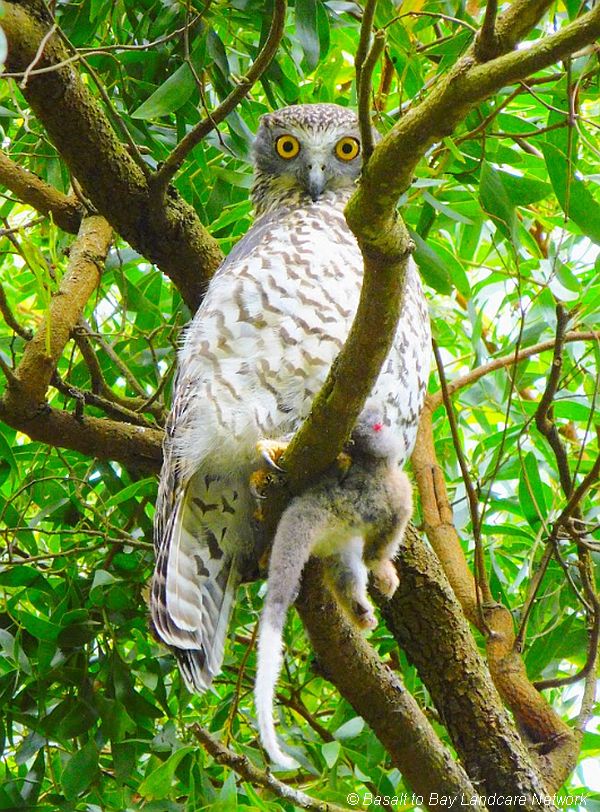
Conservation & Management
Research
- How did the owl cross the road? Movement patterns and behaviour of a threatened apex predator - ScienceDirect 2025 paper on movement ecology of powerful owls associated with roads.
- Where to fly? Landscape influences on the movement and spatial ecology of a threatened apex predator - ScienceDirect 2025 paper on how urbanisation and agriculture land-uses force powerful owls to adjust how they utilise space.
- The missing toxic link: Exposure of non-target native marsupials to second-generation anticoagulant rodenticides (SGARs) suggest a potential route of transfer into apex predators - ScienceDirect 2024 study showing rodenticide poisoning of common ringtail and brushtail possums as likely source of rodenticide poisoning of powerful owls.
- Can environmental legislation protect a threatened apex predator across different land tenures? - ScienceDirect 2024 study highlighting the inadequacy of environmental protection legislation in Victoria to protect powerful owls outside of protected areas.
- Silent killers? The widespread exposure of predatory nocturnal birds to anticoagulant rodenticides - ScienceDirect 2023 study documenting rodenticide poisoning of powerful owls, barn owls, boobook owls and frogmouths.
- Successful rehabilitation and release of a powerful owl chick with suspected rodenticide poisoning - Cooke - 2023 - Australian Veterinary Journal - Wiley Online Library 2023 study and advice to vets on how to manage suspected rodenticide poisoning in powerful owls.
- Using thresholds to determine priorities for apex predator conservation in an urban landscape - ScienceDirect 2022 study using powerful owl tracking data to establish thresholds of powerful owl conservation in urban landscapes.
- Widespread exposure of powerful owls to second-generation anticoagulant rodenticides in Australia spans an urban to agricultural and forest landscape - ScienceDirect 2022 study, and the first one on rodenticides for us showing powerful owls significantly impacted by rat poisons.
- Where to sleep in the city? How urbanisation impacts roosting habitat availability for an apex predator - ScienceDirect 2021 study showing the distribution of roosting habitats for powerful owls in response to urbanisation.
- Photography can determine the sex of a predator with limited sexual dimorphism: A case study of the powerful owl - ScienceDirect 2020 study using photos to assign the sex to adult powerful owls.
- The movement, pathways and core habitat available to the Powerful Owl in urban environments. See SWIFFT seminar notes 23 July 2020.
- Joining the dots: How does an apex predator move through an urbanizing landscape? - ScienceDirect 2019 study looking at how powerful owls move through urban landscapes with a focus on movement behaviours.
- Can owls be used to monitor the impacts of urbanisation? A cautionary tale of variable detection - CSIRO PUBLISHING | Wildlife Research 2017 study looking at the utility of playback surveys to monitor the impact of urbanisation on owls (including powerful owls).
- Species distribution models derived from citizen science data predict the fine scale movements of owls in an urbanizing landscape - ScienceDirect 2017 study looking to see how well SDMs built from citizen science data sets predicted the habitat powerful owls actually move through.
- Does urbanization have the potential to create an ecological trap for powerful owls (Ninox strenua)? - ScienceDirect 2014 study showing a potential for urbanisation to create an ecological trap for powerful owls.
- Use of Vegetative Structure by Powerful Owls in Outer Urban Melbourne, Victoria, Australia - implications for Management 2002 paper on how powerful owls use vegetation of different structure for roosting and thermal insulation.
- Predictive mapping of powerful owl (Ninox strenua) breeding sites using Geographical Information Systems (GIS) in urban Melbourne, Australia - ScienceDirect 2008 paper on predicting the extent of breeding habitat for powerful owls in response to urbanisation.
Management
- Identify at least 500 Powerful Owl Management Areas (POMA's) on public land across the known Victorian range.
- Develop or revise management prescriptions and zoning for areas of State Forest.
- Delineate POMAs in the Forest Management Planning process. Monitor at least 50% of POMAs in Benalla-Mansfield, Bendigo, Central, Goulburn Broken, Central Gippsland, Dandenong, East Gippsland, Mid-Murray, Midlands, North East, Horsham, Portland and Tambo Forest Management Areas. Also monitor POMA's in the Mt Stirling Alpine Resort, Otway Forest Park, Port Phillip & Western Port CMA and Western Gippsland Plains Group.
- Monitoring is targeted at 50% of POMAs in State Forest and 50% of POMAs in Parks or Reserves regularly to determine persistence of owls and breeding success.
- Encourage and assist Municipal Councils to develop conservation mapping and GIS overlay systems within planning schemes to improve information on owl habitat and breeding sites across private land.
- Encourage private landowners to enter into voluntary agreements (e.g. Trust for Nature covenants, Land for Wildlife Scheme) to protect owl sites on private land.
- Provide input into regional fire management and operations plans through development of a comprehensive Natural Values Asset mapping tool for use by land managers dealing with fire.
- Roads management - to support powerful owls and other wide-ranging species in urbanising landscapes, three key strategies need to be incorporated into road projects:
- protection of habitat and riparian corridors adjacent to roads
- using revegetation near roads to more adequately link movement corridors associated with riparian habitats
- limiting further road development in key road crossing points in landscapes (Carter et al. 2025).
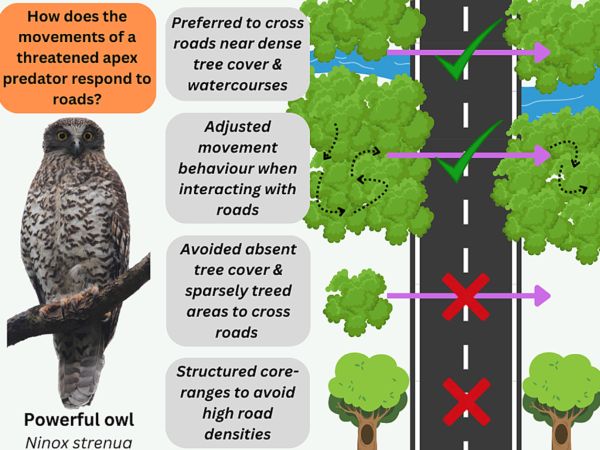
Additional conservation measures in specific areas of Victoria
North East Victoria
Goulburn Broken area - avoid the development of intensive recreational facilities near known nesting and roosting trees and discourage access to breeding areas.
Mid-Murray Area - conduct survey work in the extensive riverine Red Gum forests along the Murray River to determine if this forest type is good quality Powerful Owl habitat (in State Forest and Conservation Reserves).
Mt Buller and Mt Stirling Alpine Resorts - protect Powerful Owl nest and roost sites from mechanical disturbance during fire suppression activities.
North West Victoria
Bendigo Forest Management Area - undertake a field survey at priority locations (including existing POMAs and SPZs) to establish the distribution of individuals and breeding pairs as well as key habitat features (e.g. roosting and breeding sites) by June 2014.
In 2015, reduce the threat of habitat loss (especially the loss of large hollow-bearing trees) through the Large Owls of the Goldfields Project (field survey, determination of priority habitat zones, mapping and creation of BOMAs, SPZs and SMZs.
Dandenong Forest Management Area - conduct radio telemetry study to investigate dispersal of young Powerful Owl from natal territory and its survival.
In 2012 Deakin University undertooksurveys using owl playback and GPS tracking of captured owls tagged with transmitters.
Deakin University PhD studies into Owl genetics in Yarra Valley completed.
Avoid the development of intensive recreational facilities near known nesting and roosting trees and discourage access to breeding areas.
Parks Victoria undertakes monitoring of breeding sites on land managed by Parks Victoria e.g. Plenty Gorge (2 sites), Warrandyte State Park (4 sites), Yarra Valley Parklands (2 sites), One Tree Hill Reserve, Kinglake NP (3 sites), Dandenong Ranges NP (~3 sites), Lysterfield SP ( 2 sites).
East Gippsland
DEECA Forest Fire Management and Parks Victoria conduct large forest owl surveys in conservation reserves of East Gippsland.
Parks Victoria ensures the development of intensive recreational facilities near known nesting and roosting trees is avoided along with discouraging access to breeding areas.
Protect Powerful Owl habitat from intense and frequent burning. Protect nest and roost trees (wherever possible) from fire.
South West
Horsham - in 2015/16 DELWP undertook owl surveys as part of the West Regional Forest Agreement to improve estimation of population size and the location of breeding population.
Midlands - due to the ceasing of commercial logging operations in the Wombat Forest impacts on habitat are addressed through Wood Utilisation Plan and Fire Operations Plan.
Port Phillip & Westernport
Great Melbourne Region - a 3 year research project 2019 - 2022 conducted by N. Bradsworth, Deakin University studied Powerful Owl habitat requirements and availability in the urban environment. See SWIFFT seminar notes 23 July 2020.
Mornington Peninsula - a survey was conducted in 2013. Six females and four males recorded for the area.
Central Victoria
Protect breeding habitat in areas of Central Victoria, particularly in the Muckleford, Newstead and Castlemaine areas.
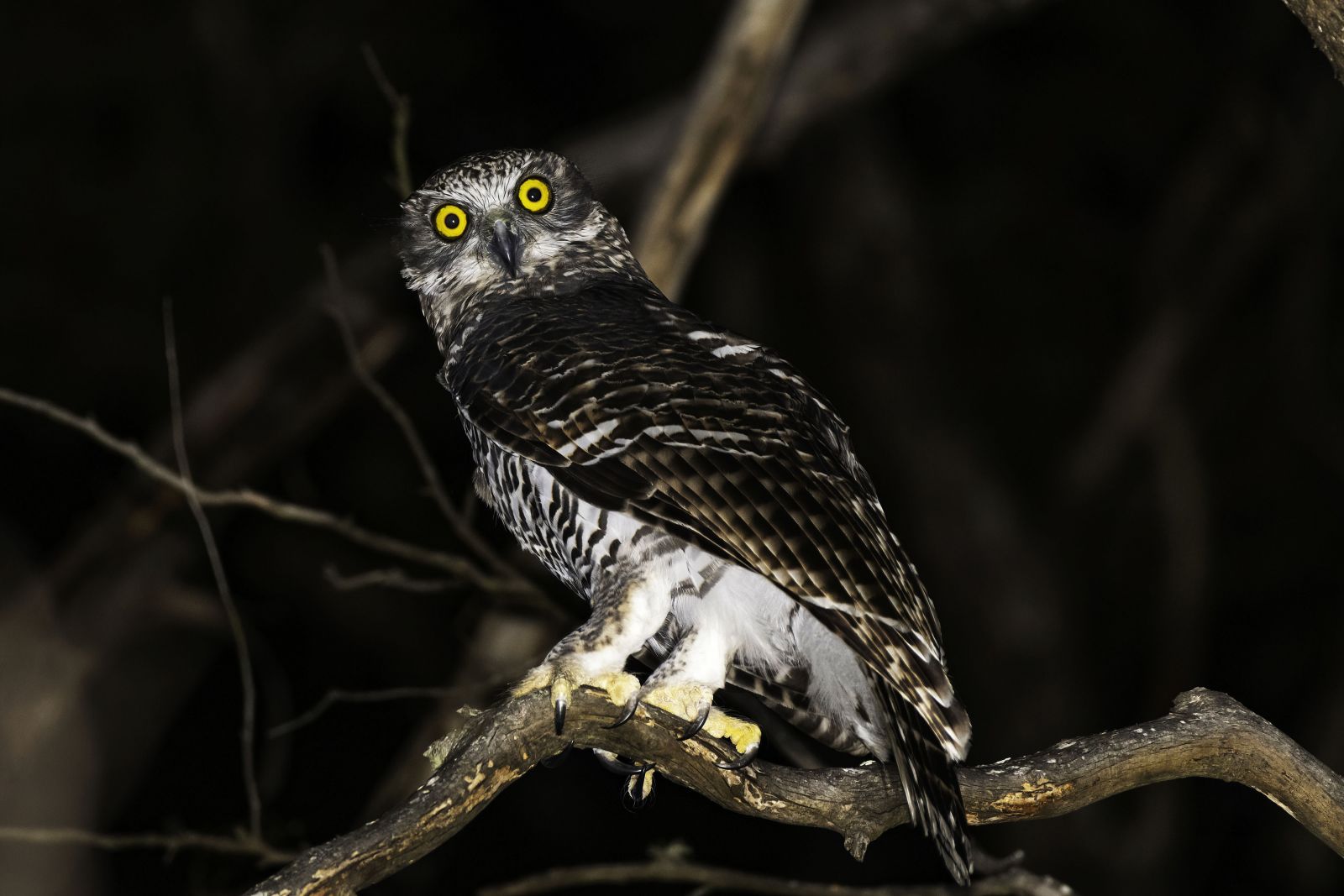
References & Links
- Atlas of Living Australia - Powerful Owl
Carter, N., White, J., Bridgeman,W., Bradsworth, N., Cooke, R. (2025) How did the owl cross the road? Movement patterns and behaviour of a threatened apex predator Biological Conservation Volume 307, July 2025, 111157 Science Direct
- Cooke, R., Wallis, R., Hogan, F., White, J., Webster, A. (2006) The diet of powerful owls (Ninox strenua) and prey availability in a continuum of habitats from disturbed urban fringe to protected forest environments in south-eastern Australia, Wildlife Research 33(3) 199–206
- Cooke, R., Wallis, R., Webester, A., (2002) Urbanisation and the ecology of powerful owls (Ninox strenua) in outer Melbourne, Victoria, In Ecology and Conservation of Owls Eds. Newton I., Kavanagh R., Olsen J., & Taylor I., CSIRO Publishing, Australia.
Cripps, J., Nelson, J., Macak, P. and Durkin, L. (2022) Arboreal mammals and large forest owls, In Biodiversity response and recovery supplementary report: bushfire impacts on species in Victoria. Department of Environment, Land, Water and Planning, Melbourne, Victoria.
- DEECA (2025) Flora and Fauna Guarantee Action Statement No 92, Powerful Owl, Department of Energy, Environment and Climate Action (DEECA), Victoria. FFG Action Statement No 92 pdf
- FFG Threatened List (2025) Department of Energy, Environment and Climate Action (DEECA).
- ICUN Red List (2025) BirdLife International. 2024. Ninox strenua. The IUCN Red List of Threatened Species 2024: https://dx.doi.org/10.2305/IUCN.UK.2024-2.RLTS.T22689389A254015323.en. Accessed on 16 April 2025.
- Kavanagh, R. (2002) Comparative diets of the Powerful Owl (Ninox strenua), Sooty Owl (Tyto tenebricosa) and Masked Owl (Tyto novaehollandiae) in southeastern Australia, In Ecology and Conservation of Owls Eds. Newton I., Kavanagh R., Olsen J., & Taylor I., CSIRO Publishing, Australia.
- Lavazanian, E., Wallis, R., Webster, A. (1994) Diet of powerful owls (Nixox strenua) living near Melbourne, Victoria, Wildlife Research 21(6) 643 – 645, Full text dx.doi.org/10.1071/WR9940643
- Loyn,R., McNabb, E., Volodina, l., Willig, R. (2002) Modelling distributions of large forest owls as a conservation tool in forest management: a case study from Victoria, southeastern Australia, In Ecology and Conservation of Owls Eds. Newton I., Kavanagh R., Olsen J., & Taylor I., CSIRO Publishing, Australia.
- McNabb, E.G. (1996) Observations on the biology of the Powerful Owl Ninox strenua in Southern Victoria, Australian Bird Watcher, 1996 Vol.16 (7), 267-295.
- Seebeck J.H. (1976) The diet of the powerful owl Ninox strenua in Western Victoria, Emu 76(4) 167 – 170, Full text dx.doi.org/10.1071/MU9760167
- Soderquist, T.R., Lowe, K.W., Loyn, R.H., Price, R. (2002) Habitat quality in Powerful Owl (Ninox strenua) territories in the Box-Ironbark forests of Victoria, In Ecology and Conservation of Owls Eds. Newton I., Kavanagh R., Olsen J., & Taylor I., CSIRO Publishing,
- Tilley, S. (1982) The Diet of the Powerful Owl, Ninox Strenua, in Victoria, Australian Wildlife Research 9(1) 157 – 175, Full text dx.doi.org/10.1071/WR9820157
- VBA (2024) Victorian Biodiversity Atlas, Department of Energy, Environment and Climate Action (DEECA), Victoria.
- VVB (2024) Visualising Victoria's Biodiversity map portal
More Information
Please contribute information regarding Powerful Owl in Victoria - observations, images or projects. Contact SWIFFT

